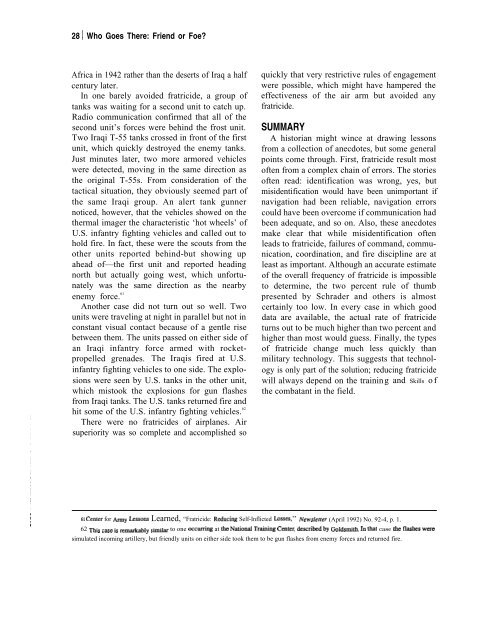Who Goes There: Friend or Foe? - Federation of American Scientists
Who Goes There: Friend or Foe? - Federation of American Scientists
Who Goes There: Friend or Foe? - Federation of American Scientists
Create successful ePaper yourself
Turn your PDF publications into a flip-book with our unique Google optimized e-Paper software.
28 I <strong>Who</strong> <strong>Goes</strong> <strong>There</strong>: <strong>Friend</strong> <strong>or</strong> <strong>Foe</strong>?<br />
Africa in 1942 rather than the deserts <strong>of</strong> Iraq a half<br />
century later.<br />
In one barely avoided fratricide, a group <strong>of</strong><br />
tanks was waiting f<strong>or</strong> a second unit to catch up.<br />
Radio communication confirmed that all <strong>of</strong> the<br />
second unit’s f<strong>or</strong>ces were behind the frost unit.<br />
Two Iraqi T-55 tanks crossed in front <strong>of</strong> the first<br />
unit, which quickly destroyed the enemy tanks.<br />
Just minutes later, two m<strong>or</strong>e arm<strong>or</strong>ed vehicles<br />
were detected, moving in the same direction as<br />
the <strong>or</strong>iginal T-55s. From consideration <strong>of</strong> the<br />
tactical situation, they obviously seemed part <strong>of</strong><br />
the same Iraqi group. An alert tank gunner<br />
noticed, however, that the vehicles showed on the<br />
thermal imager the characteristic ‘hot wheels’ <strong>of</strong><br />
U.S. infantry fighting vehicles and called out to<br />
hold fire. In fact, these were the scouts from the<br />
other units rep<strong>or</strong>ted behind-but showing up<br />
ahead <strong>of</strong>—the first unit and rep<strong>or</strong>ted heading<br />
n<strong>or</strong>th but actually going west, which unf<strong>or</strong>tunately<br />
was the same direction as the nearby<br />
enemy f<strong>or</strong>ce. 61<br />
Another case did not turn out so well. Two<br />
units were traveling at night in parallel but not in<br />
constant visual contact because <strong>of</strong> a gentle rise<br />
between them. The units passed on either side <strong>of</strong><br />
an Iraqi infantry f<strong>or</strong>ce armed with rocketpropelled<br />
grenades. The Iraqis fired at U.S.<br />
infantry fighting vehicles to one side. The explosions<br />
were seen by U.S. tanks in the other unit,<br />
which mistook the explosions f<strong>or</strong> gun flashes<br />
from Iraqi tanks. The U.S. tanks returned fire and<br />
hit some <strong>of</strong> the U.S. infantry fighting vehicles. 62<br />
<strong>There</strong> were no fratricides <strong>of</strong> airplanes. Air<br />
superi<strong>or</strong>ity was so complete and accomplished so<br />
quickly that very restrictive rules <strong>of</strong> engagement<br />
were possible, which might have hampered the<br />
effectiveness <strong>of</strong> the air arm but avoided any<br />
fratricide.<br />
SUMMARY<br />
A hist<strong>or</strong>ian might wince at drawing lessons<br />
from a collection <strong>of</strong> anecdotes, but some general<br />
points come through. First, fratricide result most<br />
<strong>of</strong>ten from a complex chain <strong>of</strong> err<strong>or</strong>s. The st<strong>or</strong>ies<br />
<strong>of</strong>ten read: identification was wrong, yes, but<br />
misidentification would have been unimp<strong>or</strong>tant if<br />
navigation had been reliable, navigation err<strong>or</strong>s<br />
could have been overcome if communication had<br />
been adequate, and so on. Also, these anecdotes<br />
make clear that while misidentification <strong>of</strong>ten<br />
leads to fratricide, failures <strong>of</strong> command, communication,<br />
co<strong>or</strong>dination, and fire discipline are at<br />
least as imp<strong>or</strong>tant. Although an accurate estimate<br />
<strong>of</strong> the overall frequency <strong>of</strong> fratricide is impossible<br />
to determine, the two percent rule <strong>of</strong> thumb<br />
presented by Schrader and others is almost<br />
certainly too low. In every case in which good<br />
data are available, the actual rate <strong>of</strong> fratricide<br />
turns out to be much higher than two percent and<br />
higher than most would guess. Finally, the types<br />
<strong>of</strong> fratricide change much less quickly than<br />
military technology. This suggests that technology<br />
is only part <strong>of</strong> the solution; reducing fratricide<br />
will always depend on the training and Skills <strong>of</strong><br />
the combatant in the field.<br />
61 Center f<strong>or</strong> ~y LMSOILS Learned, “Fratricide: Rduchg Self-Inflicted ~ss~,” Newsietrer (April 1992) No. 92-4, p. 1.<br />
62 ~s ~~e is ~-bly sw to one ~cm at the Natio~ ‘Tr~g center, de~ri~ by GoMsmith. h tkit case the fkheS Were<br />
simulated incoming artillery, but friendly units on either side took them to be gun flashes from enemy f<strong>or</strong>ces and returned fire.
















